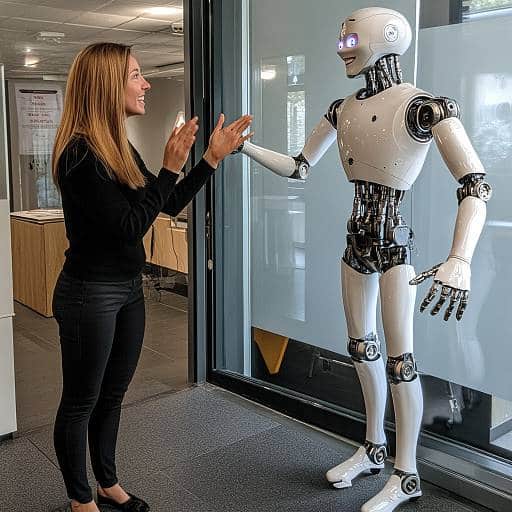“Anyone promising AI will fully automate your job is selling snake oil,” Greg Baugues says with a smile. He should know.
From tinkering with BASIC code on his TRS-80 (back in the day) to leading developer relations at Twilio, Greg truly understands cutting-edge tech and practical business challenges.
These days, as founder of haihai.ai, he’s focused on helping developers build AI applications that actually deliver.
Not the flashy autonomous agents clogging your LinkedIn feed, but the rather unsexy tools quietly transforming how businesses operate.
Greg shares what he’s learned implementing AI across hundreds of organisations.
The successes, the absolute disasters, and most crucially—how to spot the difference.
For the interview, he used AI, but not to generate the responses. Intrigued? Read on.
1. With so much AI hype in the market, what would you say to cynical business owners? What should they be excited about? And cautious of?
My number one piece of advice to sceptical business owners is to simply use the tools.
Pay $20/month for either a ChatGPT or Claude Subscription.
Install the app on your computer and phone.
Use them every day, even just for a few minutes, even if it’s just for fun, silly use-cases.
Generally, I feel like the folks saying that AI is the next BS crypto hype-wave haven’t really used the tools. Not properly, at least.
And the folks claiming that all the jobs will be automated in six months, they also haven’t used them.
These tools are new and complex.
They are unquestionably useful in some situations, and comically inept in others.
Part of your job is to develop a nuanced and informed opinion of them. The best way to do that is to get your hands dirty.
2. How can business owners distinguish between meaningful AI capabilities and marketing gimmicks when evaluating AI product claims?
As of today, the use cases where AI tools provide the most value are the ones using what we call a Human in the Loop.
These are situations where we’re using AI to augment human capabilities – in other words, helping humans do a task faster and better.
Generally speaking, tools that promise to fully automate a task are grossly underperforming.
I’m just not seeing many use cases where fully autonomous AI agents are actually delivering value – they’re typically failing, often in comical ways.
When evaluating AI tools today, look for those in the category of “co-pilots”.
Something that sits next to the app where you’re already working, helps you brainstorm, transforms bullet points into fully written text, answers questions about the project you’re working on.
Use cases where you’re still very-much involved in the creation process. That’s realistic for where we are today.
The tools promising to either fully automate your job or eliminate the need for employees are for the most part more hype than reality.
3. Could you share a couple of examples of small businesses with limited technical resources that have implemented AI with significant impact?
One of my favorite AI examples is from a friend, Jason Liu. He’s an AI engineer who started a consultancy and uses AI extensively in his content creation process.
Here’s what he does.
You’ve probably seen the note takers show up in some of your Zoom calls lately.
His workflow has AI analyze transcripts of calls with clients or potential clients to identify topics for blog content.
Then he uses AI to clean up the transcript, and finally goes over that with edits.
I really wouldn’t trust AI to fully automate content creation today, but it’s great for repurposing content and working with material that’s already in your voice.
For turning transcripts into blog posts, and blog posts into social media posts etc.
There’s also another great usage scenario.
One of the greatest challenges in content creation is the blank page problem. You’re probably familiar with that.
AI can help you get started — either by brainstorming or by taking something you’ve already created in one medium and converting it to another.
4. Beyond obvious use cases like chatbots, what overlooked AI applications consistently deliver the fastest ROI for small businesses?
One overlooked use case we’re seeing in the software development world is extracting structured data from unstructured text.
It’s a bit like shale oil deposits — we’ve long known there was value there, but the extraction was too expensive.
Until now, we never had great pattern recognition algorithms to extract structured data from unstructured text.
But LLMs are really good at this — this plays to their strengths.
For instance, let’s say you wanted to carry out Named Entity Recognition on a chunk of text to figure out what companies are mentioned.
Previously, as software engineers, we would have to write algorithms to do this sort of thing.
For example, look for the capitalized words in a sentence, and then try to figure out if it’s capitalized because it’s a name or because it’s at the beginning of a sentence.
Now you can just pass that paragraph to an LLM, and say: “What companies are mentioned here?” and it’ll give the right answer astonishingly often. And you don’t even need the state of the art LLMs to do this.
My friend Matt Makai, who I worked with at Twilio, runs plushcap.com where he tracks the blogs and technical documentation of 500 devtool companies.
He scrapes their websites and extracts structured data from their blogs—creating tags for topics, programming languages, platforms, and concepts discussed.
He’s built an impressive database of what everyone in the dev tool space is talking about.
Doing this five years ago would have required some level of manual labor for each post.
Now with local models, he runs everything on his MacBook Pro. He doesn’t care about inference speed, so these slow-running, low-cost models work perfectly for him.
5. Which industries do you see as most vulnerable to AI disruption in the next couple of years, and how should businesses in those spaces respond?
Coding is definitely one, and where I’m spending most of my time.
We’re seeing LLMs change how we write code and build software pretty rapidly.
And to be clear, I’m not saying that AI is going to automate all the developer jobs, but it is disrupting the way we write code, and changing the cost of code.
Looking broadly, I’d focus on industries where:
1. the output is large quantities of text.
2. junior employees doing grunt work that involves ploughing through and/or generating large chunks of text
I’m thinking code, lawyers, financial analysts, consultants, translators to name a few.
Any industry where the primary output is text or documents with a certain degree of repeatability. These guys are at risk.
Where juniors who bill out at $100+/hour are copying and pasting from templates, doing repetitive and tedious work that isn’t necessarily engaging, but is mentally and emotionally taxing — almost robotic.
These are the fields where large language models can probably do a first pass of a lot of that labor, or where a junior employee can now do 5x the work with the help of the LLM.
Then you have the senior employee come over the top and clean it up, much like they were already doing with junior employees’ work.
6. What non-technical capabilities should business owners be developing now to remain competitive as AI continues to evolve?
As the internet becomes flooded with AI-generated content, there’s going to be a backlash where we don’t have the time or desire to read big blocks of text from unknown and untrusted sources.
But we will have an even stronger desire for human connection — who can we trust?
I’m running a small business today, and I’m focusing on getting my face on things and doing unmistakably human activities alongside efforts to augment my business with AI.
For me, this means investing in YouTube so that people see my face and know these thoughts come from me.
I think as the technology and low-quality content expand, we’ll increasingly look to people we trust to curate information.
The non-technical capability to focus on is: how do you use AI for machine-like tasks while spending more time on truly human aspects of your work?
On building trust, caring about people, being funny, being human.
7. If you were suddenly running a small business tomorrow, what would be your first AI-related actions?
Figure out which aspects I’m most likely to get stuck on, and ask if there are ways that AI can help those jobs go faster.
This interview is a good example.
You sent me 7 questions.
My response will be in the region of a couple of thousand words.
My natural inclination is to stare at these questions, put them off, and realistically never get around to replying.
Instead, I fed these questions to Claude, and told it to ask me one at a time.
Now, the whole thing doesn’t overwhelm me.
Then I used Superwhisper, which is an LLM-powered voice dictation software, to transcribe my responses.
For me, talking is easier than typing. So this is using AI to eliminate some of my barriers and hurdles.
Of course, I stumble over my words and repeat myself while thinking out loud, so then I used Claude to edit each answer.
Then I did one final pass – the old-fashioned way – to make sure I was happy with each response.
So while there’s still some effort involved, editing is always easier than starting from a blank page.
And here’s the really cool aspect of the whole thing.
After I send this to you, I’ll work with Claude to repurpose this content.
Identifying topics for my newsletter, videos, LinkedIn posts, etc.
This is the important point.
I’m still doing the work here. This isn’t AI-generated content.
But what I have done is to use AI as a tool to reduce the friction of capturing and refining my thoughts.
8. What’s a common misconception about AI that you find yourself repeatedly correcting when speaking with business owners?
A common misconception about AI is that it’s just simply “chatting with a computer.”
The example I use to disprove this is a bit of a magic trick.
Go to chat.com. Ask it to “Pick a number between 1 and 50.”
90% of the time, it responds with 27.
Sometimes it’ll give you 17, 28, or 24. But usually, it’s 27, and it’s never 1, 2, or 50.
This happens because a large language model is doing what’s sometimes pejoratively called fancy autocomplete.
So an LLM is mimicking human responses that it’s seen before.
When humans are asked for a random number between one and 50, they rarely pick 1, 50, 2, or 49. They tend to go with something in the middle.
So it’s all about patterns and predictability.
Hence, 27 is a very human response.
This differs completely from a Python program picking a random number between 1 and 50.
That’s a trivially easy program to write — it’ll take four lines of code, run nearly instantaneously, and if you run it a million times, you’d get an even distribution across all numbers.
By contrast, ChatGPT is incredibly slow, incredibly expensive, and incredibly unreliable.
For my entire lifetime, computers have been good at generating (pseudo) random numbers.
So it’d be easy to think now that we have a chat box on the computer. “I’m just chatting with the computer” and assume it has all the capabilities and behaviors that computers historically had.
LLMs are an entirely new class of tools with brand-new strengths and brand-new failure modes.
For example, so-called AI hallucinations are something we’re not used to.
If a web page fails to load, you get an error.
You don’t get a webpage made up on the fly, based on the URL, pretending to be the thing you were looking for.
I’ve been coding since learning BASIC on a TRS-80, and the last two years have been the most fun I’ve had programming since then!
But there have been many times over the last two years when I’ve had to close my laptop and walk around the block to let my brain rewire itself.
Why? Because the new frameworks of what’s possible run contrary to so much that I’ve grown accustomed to over the last few decades.
LLMs are an entirely new tool class with new strengths, failure modes, exciting possibilities and potential dangers.
The best way to understand what problems these new tools solve well is simply to start using them.
So your next step?
Greg’s parting advice circles back to where we started:
The best way to understand these tools is to just start using them.
Get a subscription, experiment, and push the boundaries a little. The results might surprise you – they certainly surprised me.
Unique ideas for your business
The Demystifier puts practical ideas into your hands. You won't find them elsewhere. Original, actionable and insanely effective.






